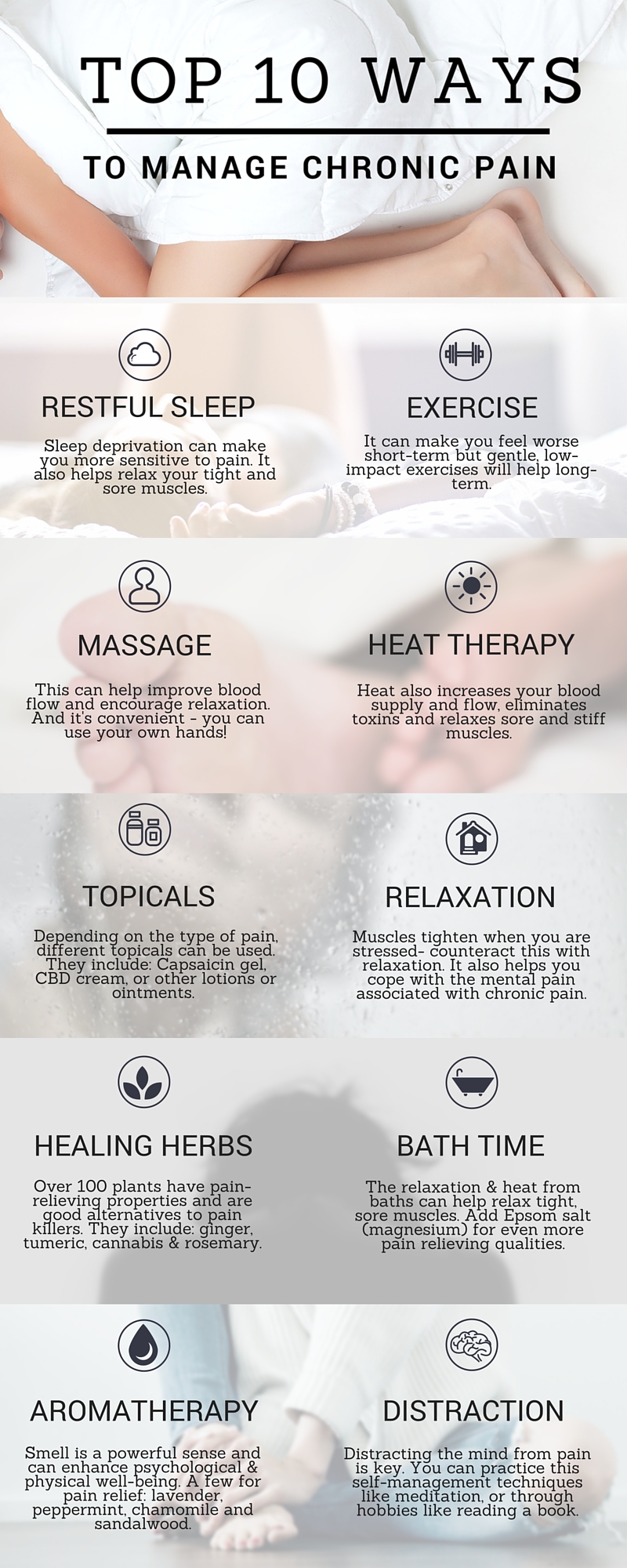1. Restful Sleep
Getting good sleep is critical for reducing chronic pain, improving your energy, and your mood. Getting a full 8 hours of rest is key for the mind and body. After an injury, muscles tighten to reduce the risk of re-injury, and it can sometimes be difficult to relax those muscles once again. Sleeping gives your muscles a good 8 hours of rest and relaxation. Furthermore, sleep deprivation can make you more sensitive to pain. But good sleep doesn’t just help us physically, it also relaxes the mind, and helps us manage the everyday stress that’s associated with chronic pain.
2. Exercise
Exercise can make you feel worse short-term, but the lack of it will make your symptoms worse long-term. That said, high-impact exercises should be avoided. Instead, aim for gentle, low-impact exercises, like yoga, Pilates or tai chi, which are helpful for improving flexibility, strength, balance and relaxation.
3. Massage
Massaging is helpful and convenient. A good massage can reduce tension and pain by improving your blood flow and encouraging relaxation. And it’s convenient, because you always have your hands on you to give yourself a massage!
If your hands get tired, you can also invest in a few simple tools including foam rollers and tennis balls.
4. Heat Therapy
While cold therapy can be helpful for acute pain, it should be noted that heat therapy is better for chronic pain. Heat increases your blood supply and therefore blood flow. Heat also stimulates the release and elimination of toxins.
Overall, heat relaxes soreness and stiffness from muscles. You can use heating pads and heating wraps to treat pain with heat.
5. Topicals
Because all topicals are slightly different, they are all used to relieve different types of pain. For example, Capsaicin relieves pain from joints, muscles and nerves. Salicylates work well for pain, particularly in joints that are close to the skin. Counterirritants (such as menthol) create a burning or cooling sensation to distract you from pain.
However, if you are like me, you have tried dozens of different topicals, and none seem to work well enough. If you can’t seem to find one that works well for you, try a CBD cream. You can also ingest, smoke or vape CBD.
6. Relaxation
Muscles tighten even more when we are stressed. You can counteract this through relaxation techniques. Relaxation can also work similarly to distraction (below); extreme relaxation can make you stop thinking about the pain. Relaxation techniques include: deep breathing and meditation, massage, vinyasa yoga, and music and art therapy.
7. Healing Herbs
There are over 100 plants that are known to have pain-relieving properties. Using these plants are good alternatives to anti-inflammatory drugs and other pain killers to manage chronic pain. Ginger, Turmeric, Rosemary and even cannabis are known for their pain-relieving qualities.
8. Bath Time
Taking a bath is mentally and physically relaxing. As previously noted, heat therapy can be especially beneficial for those suffering from chronic pain – especially when it is moist heat. It can also relax your mind, just like a good nights rest.
You can also add Epsom salt to your bath, which contains magnesium. Magnesium supplements can help with pain associated with migraines, muscle spasms, fibromyalgia, and is best absorbed through the skin (rather than through the digestive tract).
9. Aromatherapy
Aromatherapy is the practice of using natural oils, extracted from plants, to enhance psychological and physical well-being. They can be either absorbed through the skin, or inhaled – which is especially beneficial as the sense of smell is one of the most powerful.
The essential oils associated with pain relief are: chamomile, lavender, peppermint, rosemary and sandalwood.
10. Distraction
Distracting the mind from pain is key for those suffering from chronic pain. Not only does it help relieve the actual pain, it also relieves the stress that results from consistent pain.
You can practice distracting yourself through self-management techniques like meditation. Or you can instead use more stimulating activities or hobbies that will consistently occupy your attention, such as reading a book, or even exercise.



